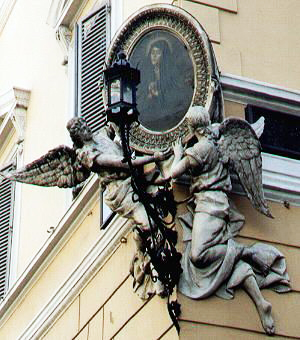When visitors arrive in Rome for the first time, they are overwhelmed by the sites and antiquities throughout the Eternal City. Usually it dawns on them either during the day of touring or while wandering through Rome’s many streets, lanes and alleys, that they are often confronted by images of the Virgin Mary. The countless images of the Holy Mother, in the form of statues and paintings, were placed on the corners of humble houses and beautiful palazzos to protect, not only the inhabitants of the dwelling, but also those passing by. Saying the Hail Mary prayer was a means of protection and would prevent demons from haunting the unfortunate souls they encountered. One of the reasons that you find the Madonna on so many street corners has its roots in a pagan superstition that at night demons came up from underground where roads crossed to prey upon the living.
An oil lamp was always lit before these beautiful images, both as proof of devotion and to shed light on places that were dark and sometimes dangerous at night. This was in a time when there was no form of public lighting. Unfortunately the lighting of the locations also had unintended consequences. They became meeting places for rather unseemly characters and some of the activities that occurred in the presence of the Blessed Mother’s image were anything but holy!
During the 15th and 16th centuries, ecclesiastical authorities decided to move these holy images inside churches and basilicas, where they would be sheltered from the weather and the activities in the street. It was also intended to attract the city’s many devout pilgrims directly into the churches.
Many churches, such as the Church of the Gesù, display images of the Madonna that are typical of ancient and popular traditions. An endless succession of faithful pay homage to the “Madonna of the Street” in the Church’s chapel. In 1538, Saint Ignatius of Loyola prayed in front of this same image. At that time it was on one of the altars in the Church of Mary of the Street, in Via degli Astalli. Saint Francis Xavier often kneeled in front of the holy image. In 1540, the parish church was replaced by the monumental Church of the Gesù, where the founder of the Society of Jesus was laid to rest and this is where the image of the Virgin was transferred.
Moving the pictures of the Holy Mother inside did not sit well with the people of Rome. Over the centuries, they had become attached to and reassured by Mary’s presence on the streets. In response, building owners took it upon themselves to add new images of the Virgin to protect their homes. As pictures and statues of Mary were moved indoors, the alcoves that previously housed statues of the Virgin were given small roofs and new statues were placed there by the faithful. Glass frames were installed to protect the paintings and stone surrounds were carved to better shield the image of the Holy Mother. Their devotion has continued and transcended time through to the present.
No one is sure exactly how many images of Mary exist on the streets of Rome. One estimation is as low as 500, an impressive number, but far, far lower than the actual total. At last count, the streets of Rome contain over 2,000 images of the Virgin Mother! Anywhere you are and anywhere you are going, just slightly lift your gaze and you are likely to see her image as you walk across the streets, or the squares of the Eternal City. Some of the pictures have greater artistic merit than others and some may have a candle lit in front of the picture. Others may be framed, but all represent the admiration and devotion to the Blessed Mother Mary.
The next time that you are walking through Rome’s historic center, silently say the Hail Mary prayer when you see the Madonna, for she has braved all manner of weather over the centuries and has endured as a beacon of hope for the faithful…and so it should be…now and forever.





